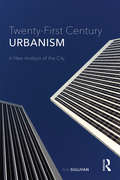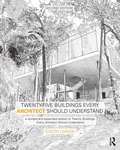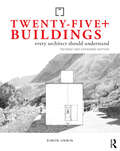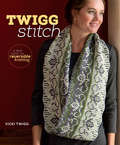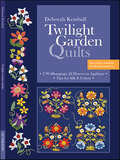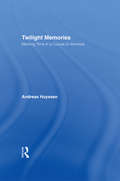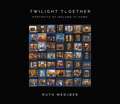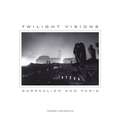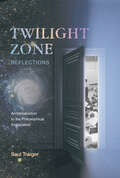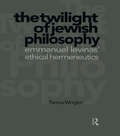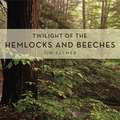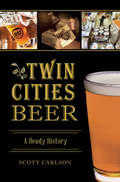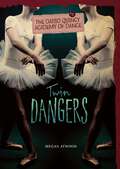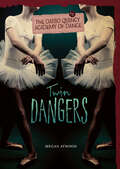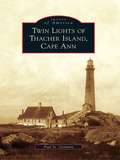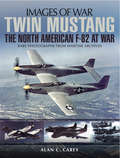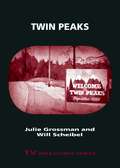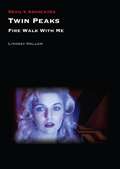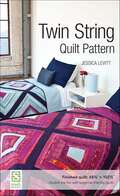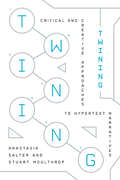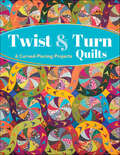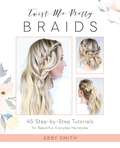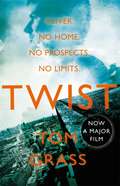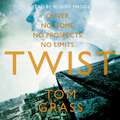- Table View
- List View
Twenty-First Century Urbanism: A New Analysis of the City
by Rob SullivanThis volume argues that the city cannot be captured by any one mode of analysis but instead is composed of the mobile, relational, efficient, sentient, and the phenomenological with all of them cast in new theoretical configurations and combined into one methodological entity. Rather than focusing on any one city or abstract analytical model, this book instead takes a multipronged theoretical and methodological approach to present the city as an intelligent affective organism – a sentient being. It proposes that cities operate on a relational, mobile, and phenomenological basis through the mode of efficiency, calibrated by a profoundly complicated division of labor. Its starting point is that the city is a mobile unit of analysis, from its economic status to its demographic makeup, from its cultural configuration to its environmental conditions, and therefore easily evades our quantitative and qualitative methods of computation and comprehension. Twenty-First Century Urbanism provides planning and urban design academics and students with a multifaceted approach to understanding the development of cities, encouraging the examination of cities through a myriad, non-linear approach.
Twenty-Five Buildings Every Architect Should Understand: a revised and expanded edition of Twenty Buildings Every Architect Should Understand
by Simon UnwinTwenty-Five Buildings Every Architect Should Understand is an essential companion to Simon Unwin's Analysing Architecture, and part of the trilogy which also includes his Exercises in Architecture: Learning to Think as an Architect. Together the three books offer an introduction to the workings of architecture providing for the three aspects of learning: theory, examples and practice. Twenty-Five Buildings focusses on analysing examples using the methodology offered by Analysing Architecture, which operates primarily through the medium of drawing. In this second edition five further buildings have been added to the original twenty from an even wider geographical area, which now includes the USA, France, Italy, Mexico, Switzerland, Spain, Finland, Germany, Australia, Norway, Sweden, India and Japan. The underlying theme of Twenty-Five Buildings Every Architect Should Understand is the relationship of architecture to the human being, how it frames our lives and orchestrates our experiences; how it can help us make sense of the world and contribute to our senses of identity and place. Exploring these dimensions through a wide range of case studies that illustrate the rich diversity of twentieth and twenty-first century architecture, this book is essential reading for every architect.
Twenty-Five+ Buildings Every Architect Should Understand: Revised and Extended Edition
by Simon UnwinThe underlying theme of Twenty-Five+ Buildings Every Architect Should Understand is the relationship of architecture to the human being, how it frames our lives and orchestrates our experience; how it can help us make sense of the world and contribute to our sense of identity and place. Exploring these dimensions through a wide range of case studies that illustrate the rich diversity of twentieth- and twenty-first-century architecture, this book is essential reading for every architect. With the addition of numerous shorter analyses, this new edition covers an even greater range of architectural ideas, providing students and architects with further inspiration for exploration in their own design work. Architects live by ideas. But where do they come from? And how do they shape buildings? There is no one right way to do architecture. This book illustrates many. Its aim is to explore the rich diversity of architectural creativity by analysing a wide range of examples to extract the ideas behind them. Twenty-Five+ Buildings Every Architect Should Understand is a companion to Simon Unwin’s Analysing Architecture: the Universal Language of Place- Making (most recent edition, 2021), and part of the trilogy which also includes his Exercises in Architecture: Learning to Think as an Architect (second edition, 2022). Together the three books offer an introduction to the workings of architecture providing for the three aspects of learning: theory, examples and practice. Twenty-Five+ Buildings focusses on analysing examples using the methodology offered by Analysing Architecture, which operates primarily through the medium of drawing. An underlying theme of Twenty-Five+ Buildings Every Architect Should Understand is the relationship of architecture to the human being, how it frames our lives and orchestrates our experiences; how it can help us give form to the world and contributes to our senses of identity and place. Exploring these dimensions through case studies that illustrate the rich diversity of twentieth- and twenty-first-century architecture, this book is essential reading, and hopefully an inspiration, for every architect. In this new edition supplementary analysis and discussion has been added to each of the twenty-five case studies, drawing attention to their influences from and on other architects. A number of extra shorter analyses have been included too, following the practice of presenting extra small dishes interspersed among main courses in high-end restaurants. These additional short analyses account for the + sign after ‘Twenty-Five’ in the title of this edition, and double the number of buildings analysed to around fifty.
Twigg Stitch: A New Twist on Reversible Knitting
by Vicki TwiggA brand-new technique for creating completely reversible knits. Readers will discover a new type of color knitting that produces a fully reversible fabric with mirrored or completely different sides. Worked by knitting two yarns at the same time, Twigg stitch allows the knitter to create two completely different fabrics. Not only can the knitter create simple reversible colorwork, but also different cable patterns or even lace that is a different color on each side. Unique and fascinating as the technique is, it's not difficult to master. Anyone with basic knitting skills can quickly learn. Vicki will teach the basics of Twigg stitch: casting on, handling yarns, increasing and decreasing, changing colors, and knitting in the round. She also provides a stitch dictionary of basic to more complex color patterns, textured patterns, and cables. Ten patterns round out the book, from simple hats and mitts, demonstrating the stitch in its most basic form, to a shaped lace shawl.
Twilight Garden Quilts
by Deborah KemballA floral vision You'll be tempted to gather all of these vibrant flowers into a luscious bouquet! Juxtaposed against dark backgrounds, the florals featured on these two patterns pop. Create a variety of lovely silk or cotton quilts with 2 full-size appliqué patterns featuring curving blooms, petals, and vines. Plus, you can use the blocks individually from the 9-block quilt to make pillows, table runners, smaller quilts…wherever you want to dazzle with a jewel tone flower show. • Complete instructions and 2 full-size patterns for wallhanging quilts • 22 floral elements linked in flowing elegance • Use any appliqué method you choose: hand or machine, turned-edge, or raw edge. Instructions are given for hand appliqué using freezer paper templates
Twilight Memories: Marking Time in a Culture of Amnesia
by Andreas HuyssenIn this new collection of essays on memory and amnesia in the postmodern world, cultural critic Andreas Huyssen considers how nationalism, literature, art, politics, and the media are obsessed with the past. The great paradox of our fin-de-siecle culture is that novelty is even more associated with memory than with future expectation. Drawing heavily on the dilemmas of contemporary Germany, Huyssen's discussion of cultural memory illustrates the nature of contemporary nationalism, the work of such artists and thinkers as Anselm Kiefer, Alexander Kluge, and Jean Baudrillard, and many others. The book includes illustrations from contemporary Germany.
Twilight Together: Portraits of Ireland at Home
by Ruth Medjber'A moving and uplifting record of our nation's lockdown' Sunday IndependentThe essential book for 2020, capturing the heart-breaking and uplifting stories that made it a year we will never forgetIn March 2020, the arrival of Coronavirus in Ireland saw our world change overnight. We watched in shock as it spread throughout the world with devastating consequences. We stopped travelling, we worked from home, we celebrated birthdays, anniversaries and new arrivals via our screens. Many also had to grieve from a distance, isolated and alone.But the pandemic also became a time of coming together, of community spirit, of small kindnesses and boundless creativity. We saw frontline workers make extraordinary sacrifices, musicians perform from their front rooms, neighbourhood bingo and open-air film screenings.In Twilight Together Ruth Medjber has captured all of this and more. Visually stunning and deeply moving, she has photographed people all over Ireland at their front window at dusk, each with their own story to tell. Twilight Together is an extraordinary portrait of a pandemic by one of Ireland's most talented photographers and it is an important document for our times.
Twilight Visions: Surrealism and Paris
by Therese LichtensteinFor generations, Paris after-hours has captured the imagination of the city's inhabitants and its visitors in equal measure. Whether prompted by the reflection of lights along the Seine, the nonchalance of café life, the atmosphere of romance, its reputation for sensual and carnal pleasures, its intellectual and creative citizenry, or some combination of all these things, we tend to anthropomorphize the city as a mysterious and inspirational source. The period between the two world wars was an especially fertile time in Paris, which became a crucible for the emergence of Surrealism. Intense interpretations of inner worlds came together with challenges to distinctions between high and low culture as Parisian writers, critics, and artists spawned the creative effulgence of the Surrealist movement, whose influence would endure throughout the twentieth century.
Twilight Zone Reflections: An Introduction to the Philosophical Imagination
by Saul TraigerTwilight Zone Reflections is the first book of its kind to explore the entirety of The Twilight Zone (1959–1964) as a series. It acts as both an introduction to the field of philosophy and as a complete guide to the philosophical issues illustrated throughout the original 1959-64 television series. Author Saul Traiger explores each of the 156 episodes, investigating the show’s themes in metaphysics, epistemology, moral and political philosophy, and other topics in a way that is accessible to both seasoned philosophers and those outside academia. Each short chapter dives into a single episode and concludes with helpful cross-references to other episodes that explore similar philosophical problems and subjects. For example, a reader may be interested in questions about the nature of the mind and whether machines can think. By referencing this book, they could easily discover the thematic connections between episodes like “I Sing the Body Electric” or “The Lateness of the Hour,” and learn how both episodes introduce the viewer to possible worlds that challenge us to consider whether our idea of the mind, and even our very personhood, extends beyond the human to robots and other artificial intelligences. Each chapter introduces fundamental philosophical questions such as these through the lens of The Twilight Zone and inspires additional exploration. Further readings are suggested for all episodes, making this volume indispensable to academics, students, and fans of the show. Each chapter is short and accessible, ensuring that this book is the perfect resource to accompany a complete series re-watch. The Twilight Zone considered questions that strike at the heart of philosophical inquiry, such as the nature of self, the existence of god, the possibility of an afterlife, the relationship between knowledge and mental illness, the nature of possibility, even the nature of imagination itself, and so much more. Traiger argues that each episode can serve as an entry point for philosophical reflection. Twilight Zone Reflections is a valuable reference for anyone interested in exploring a well-known slice of popular culture history that doubles as a vast store of philosophical ideas.
Twilight of Jewish Philosophy
by Wright Dr Tamra WrightFirst Published in 1999. Routledge is an imprint of Taylor & Francis, an informa company.
Twilight of the Hemlocks and Beeches (Keystone Books)
by Tim PalmerIn this magnificently illustrated book, conservationist and celebrated outdoors photographer Tim Palmer launches us on a revealing journey among the hemlock and beech trees that have for millennia towered over America’s eastern woodlands. The eastern hemlock and North American beech once thrived from Maine to Georgia, casting shade on trout streams, nourishing wildlife large and small, and gracing uncounted valleys, mountainsides, parks, and backyards. These trees now face tragic decimation by exotic insects and pathogens. Palmer’s photos record the splendor of the cherished hemlock and beech in the same way that pictures of iconic, historic buildings commemorate classic landmarks gone the way of the wrecking ball. And yet, as Palmer underscores in his final chapter, the lessons learned as we address the fate of these trees can help us chart a better course for all wooded landscapes in the years ahead. This story of loss, scientific inquiry, and prospective recovery is vital to understanding nature in our time.As an act of artistic preservation, a report on the science vital to the survival of these trees, and a call to action, Twilight of the Hemlocks and Beeches assures a lasting legacy for this irreplaceable forest community. With more than one hundred exquisite full-color photographs, this book is a must-have for outdoor enthusiasts, natural historians, ecologists, and all lovers of nature.
Twilight of the Hemlocks and Beeches (Keystone Books)
by Tim PalmerIn this magnificently illustrated book, conservationist and celebrated outdoors photographer Tim Palmer launches us on a revealing journey among the hemlock and beech trees that have for millennia towered over America’s eastern woodlands. The eastern hemlock and North American beech once thrived from Maine to Georgia, casting shade on trout streams, nourishing wildlife large and small, and gracing uncounted valleys, mountainsides, parks, and backyards. These trees now face tragic decimation by exotic insects and pathogens. Palmer’s photos record the splendor of the cherished hemlock and beech in the same way that pictures of iconic, historic buildings commemorate classic landmarks gone the way of the wrecking ball. And yet, as Palmer underscores in his final chapter, the lessons learned as we address the fate of these trees can help us chart a better course for all wooded landscapes in the years ahead. This story of loss, scientific inquiry, and prospective recovery is vital to understanding nature in our time.As an act of artistic preservation, a report on the science vital to the survival of these trees, and a call to action, Twilight of the Hemlocks and Beeches assures a lasting legacy for this irreplaceable forest community. With more than one hundred exquisite full-color photographs, this book is a must-have for outdoor enthusiasts, natural historians, ecologists, and all lovers of nature.
Twin Cities Beer: A Heady History (American Palate)
by Scott CarlsonThe Twin Cities witnessed a recent explosion of craft beer breweries and brewpubs, but the region's beer history reaches back generations. The Minneapolis Brewing Company introduced the iconic Grain Belt beer in 1893, and it remains a local favorite. Fur trapper and bootlegger Pierre "Pig's Eye" Parrant established a St. Paul tavern along the banks of the Mississippi River in the early 1800s. The area has been home to some of the best-known beer brands in America, from Hamm's and Schmidt's to Yoerg's and Olympia. Today, microbreweries such as Bad Weather Brewing, Summit Brewing and more than fifty others are forging new avenues. Join author Scott Carlson as he offers an intriguing history and guide to Twin Cities beer.
Twin Dangers (The Dario Quincy Academy of Dance #4)
by Megan AtwoodEmma knows that Sophie is dying for the chance to "dance a pas de deux"with her big crush, Trey. Twin sisters know everything about each other. So when Emma secretly hooks up with Trey herself, Sophie feels twice as betrayed. While Sophie might be upset, she's not angry enough to send her sister death threats. Even so, when menacing notes reach Emma, Sophie's the top suspect. Will Sophie clear her name and save her twin? Or will one of the Dario Quincy Academy's dark secrets destroy them both?
Twin Dangers (The\dario Quincy Academy Of Dance Ser.)
by Megan AtwoodEmma knows that Sophie is dying for the chance to "dance a pas de deux"with her big crush, Trey. Twin sisters know everything about each other. So when Emma secretly hooks up with Trey herself, Sophie feels twice as betrayed. While Sophie might be upset, she's not angry enough to send her sister death threats. Even so, when menacing notes reach Emma, Sophie's the top suspect. Will Sophie clear her name and save her twin? Or will one of the Dario Quincy Academy's dark secrets destroy them both?
Twin Lights of Thacher Island, Cape Ann
by Paul St. GermainThacher Island was named for Anthony Thacher who, in 1635, lost his four children and other family members in a shipwreck during the most severe storm to ever hit the Massachusetts coast. Only Anthony and his wife Elizabeth survived. The lighthouses have played an important role in several wars, including the Revolutionary War and World Wars I and II, when the navy established a radio compass station to protect the coast from enemy submarines. A ship bearing a U.S. president almost wrecked on Thacher Island, and the island was used as a witness protection site for a Mafia criminal. Twin Lights of Thacher Island, Cape Ann captures the history, adventures, and intimate stories from over 200 years of lighthouse keepers living on the island, including how the two towers were built and how scientific discoveries were applied to improve the lights over the years.
Twin Mustang: The North American F-82 at War (Images of War)
by Alan C. Carey&“A comprehensive look at the 272-plane F-82 fleet . . . This is a fine addition to Carey&’s body of work and to anyone&’s aviation library.&”—HistoryNet One of the most unusual and remarkable American fighter aircraft, the F-82 Twin Mustang was the last mass production propeller-driven fighter acquired by the U.S. Air Force. Originally intended as a very long-range fighter escort for the Boeing B-29 Superfortress during World War II, it arrived too late to see combat and evolved into a night and all-weather fighter during the post-war years. Combat operations in the Korean War followed, along with a host of other dynamic episodes of deployment. This work traces the developmental, operational, and combat history of this unique American fighter and features 120 photographs and illustrations, many of which have never been published before. Seven chapters, all extensively illustrated, cover the aircraft&’s development, descriptions of the variants and sub-types, details of initial entry into service, three chapters covering the F-82&’s service in the Korean War, and a final chapter detailing the type&’s removal from the Korean War Theatre in February 1952, to see out its operational days in the Alaskan Air Defense Command. &“If you&’re an historian like me, you&’ll love this book. It lists every F-82 to serve in Korea, every crewman lost in combat, every squadron which used them, and all the pertinent tech details about each version. Photos illustrate the planes from nearly every squadron (if not all) and captions offer in-depth information not included in the text—so they really add value.&”—My Hobby Info
Twin Peaks (TV Milestones Series)
by Will Scheibel Julie GrossmanJulie Grossman and Will Scheibel’s enthusiastic book on the television series Twin Peaks takes fans through the world that Mark Frost and David Lynch created and examines its impact on society, genre, and the television industry. Grossman and Scheibel explore the influences of melodrama and film noir, the significance around the idea of "home," as well as female trauma and agency. In addition to this close investigation of the series itself, the authors examine the rich storytelling surrounding Twin Peaks that includes the film prequel, Mark Frost’s novels, and Showtime’s 2017 revival. In Twin Peaks, Grossman and Scheibel argue that the show has transcended conventional binaries not only in film and television but also in culture and gender. The book begins with a look into the publicity and critical discourses on authorship that framed Twin Peaks as an auteurist project rather than a prime-time soap opera. Despite critics’ attempts to distance the series from the soap opera genre, Grossman and Scheibel explore how melodrama and noir are used in Twin Peaks. Grossman and Scheibel masterfully examine star performances in the series including Kyle MacLachlan’s epic portrayal as the idiosyncratic Special Agent Dale Cooper and Sheryl Lee’s haunting embodiment of Laura Palmer. The monograph finishes with an examination of the adaptation and remediation of Twin Peaks in a variety of different platforms, which have further expanded the boundaries of the series. Twin Peaks explores the ways in which the series critiques multiple forms of objectification in culture and textuality. Readers interested in film, television, pop culture, and gender studies as well as fans and new audiences discovering Twin Peaks will embrace this book.
Twin Peaks: Fire Walk with Me (Devil's Advocates)
by Lindsay HallamWhen David Lynch’s film Twin Peaks: Fire Walk with Me, a prequel to the television series Twin Peaks, premiered at the 1992 Cannes Film Festival it was met with met with outright hostility. Subsequent reviews from critics were almost unanimously negative, and many fans of the show felt betrayed, as their beloved town was suddenly revealed as a personal hell. Yet in the years since the film’s release, there has begun to be a gradual wave of reappraisal and appreciation, one that accelerated with the broadcast of Twin Peaks: The Return in 2017. What has been central to this reevaluation is the realization that what Lynch had created was not a parody of soap opera and detective television but a horror movie.In this Devil’s Advocate, Lindsay Hallam argues that the horror genre aids Lynch’s purpose in presenting the protagonist Laura Palmer’s subjective experience leading to her death as the incorporation of horror tropes actually leads to a more accurate representation of a victim’s suffering and confusion. She goes on to explore how the film was an attempt by Lynch to take back ownership of the material and to examine the initial reaction and subsequent reevaluation of the film, as well as the paratexts that link to it and the influence that Fire Walk with Me now has on contemporary film and across popular culture.
Twin String Quilt Pattern
by Jessica LevittGo bold with big blocks Indulge in your favorite hue (or two!) with fabric designer Jessica Levitt. Bright and bold quilt blocks pair same-color prints with strong solids for depth and lots of personality. Stitch random-width strips to a muslin base for a planned approach to improv. Giant-size blocks join together like a fun puzzle, forming a graphic secondary pattern when you piece the quilt top! Big blocks from bold solids and prints Foundation piecing is fun and easy on muslin fabric Tips from fabric designer and modern quilter Jessica Levitt For quilters of all skill levels Wholesale minimum: 3 units.
Twining: Critical and Creative Approaches to Hypertext Narratives
by Anastasia Salter Stuart MoulthropHypertext is now commonplace: links and linking structure nearly all of our experiences online. Yet the literary, as opposed to commercial, potential of hypertext has receded. One of the few tools still focused on hypertext as a means for digital storytelling is Twine, a platform for building choice-driven stories without relying heavily on code. In Twining, Anastasia Salter and Stuart Moulthrop lead readers on a journey at once technical, critical, contextual, and personal. The book’s chapters alternate careful, stepwise discussion of adaptable Twine projects, offer commentary on exemplary Twine works, and discuss Twine’s technological and cultural background. Beyond telling the story of Twine and how to make Twine stories, Twining reflects on the ongoing process of making. "While there have certainly been attempts to study Twine historically and theoretically... no single publication has provided such a detailed account of it. And no publication has even attempted to situate Twine amongst its many different conversations and traditions, something this book does masterfully." —James Brown, Rutgers University, Camden
Twist & Turn Quilts: 6 Curved-Piecing Projects
by Cinzia WhiteChallenge yourself with an intricate curved-piecing design Stunning movement in a quilt; a chain of arrows directs the viewer’s eyes to follow and explore the quilt through the middle of the paths! This original design is suitable for various fabrics and highlights exquisite circular and hexagonal patterns. Interlocking paths are the foundation for all six quilt projects — king-size quilt, queen-size quilt, double-queen quilt, twin-size quilts (2), and lap. Each project size has its own design and instructions. Beginners can enjoy the process using the simple step-by-step instructions, but along the way, enjoy the satisfaction of completing an intricate and advanced quilt. Infinite design possibilities — every quilt can be different simply through fabric selection Perfect for hand or machine piecing Step by step instructions make this advanced-level project easy
Twist Me Pretty Braids: 45 Step-by-Step Tutorials for Beautiful, Everyday Hairstyles
by Abby SmithBEAUTIFUL BRAIDS FOR ANY OCCASIONYour hair is your best accessory. Learn how to dress it up with these creative, exciting styles!• Looped Accent Braid• Pull-Through Ponytail• Corset Braid• Four-Strand Braid• Mixed Crown Braid• Uneven Center Braid• And more!
Twist: The electrifying heist thriller – now a major movie
by Tom GrassPacked with action, love and betrayal, Tom Grass's electrifying heist thriller is a gripping reinvention of the Dickens classic, OLIVER TWIST.Now a major film starring Michael Caine, Lena Headey, Rita Ora and Raff Law.Eighteen-year-old Twist doesn't have much. No money, no home and no family. All he has is his reputation as one of the most daring street artists in London - whose unique skills are matched only by his infamous talent as a climber and freerunner.But when he finds himself on the run from the police, he knows that he could be about to lose the last thing he has left - his freedom. Until he is saved by the mysterious Dodge. When Dodge introduces him to con artist and art 'collector' Cornelius Faginescu, Twist realises that he finally has the chance to be part of something. All that he has to do is put aside his moral objections and learn to steal...
Twist: The electrifying heist thriller – now a major movie
by Tom GrassEighteen-year-old Twist doesn't have much. No money, no home and no family. All he has is his reputation as one of the most daring street artists in London - whose unique skills are matched only by his infamous talent as a climber and freerunner.But when he finds himself on the run from the police, he knows that he could be about to lose the last thing he has left - his freedom. Until he is saved by the mysterious Dodge. When Dodge introduces him to con artist and art 'collector' Cornelius Faginescu, Twist realises that he finally has the chance to be part of something. All that he has to do is put aside his moral objections and learn to steal...Read by Robert Madge(p) 2014 Orion Publishing Group
